Craft Traditions - Rug Hooking
Since colonial times, women of Northern New England have made use of old bits of clothing and fabric scraps to fashion rugs for their families and friends. The two most popular methods of making a rug are hooking and braiding.
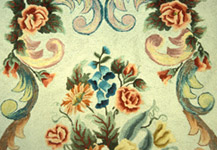
This hooked rug with a traditional
floral design was created by
Dot Towle of Intervale, NH.
Wool is the favored fiber for hooked rugs. It is treasured for its warmth and up until recently, was widely available in New Hampshire.
In the early to mid 1800s sheep farms were common and many New Hampshire women spun wool for their family's clothing. From the mid 1800s to early 1900s textiles mills supported a thriving woolen industry and many rug makers were able to buy "end rolls" or "end cuts" of fabric woven for the clothing industry. Because few sheep farms remain and most of the mills have shut down, affordable access to woven wool is becoming more of a challenge for today's rug makers.
Making a durable and beautiful hooked rug requires patience and nimble fingers. The basic technique is to hold a thin strip of wool on the back side of a piece of coarsely woven fabric, like burlap or cotton, and draw small loops of the woolen strip through the openings of the weave using a hand held hooking tool. Nice even loops are the mark of a rug hooker's skill.
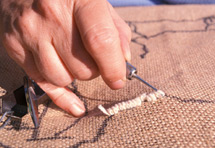
Pulling up nice even loops of
stripped wool through a burlap
backing takes skill and patience.
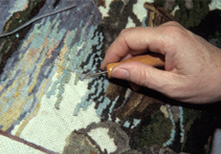
Pam Bartlett dyes her own wool
to create the many subtle
colors needed for the sky
and landscape of this rug
The backing fabric is usually stretched out and secured on a small frame and the design of the rug is sketched out beforehand. In New England, the designs of hooked rugs are often floral, but are just as often designs created by the rug maker of favorite memories or landscapes.
Some rug makers prefer what are sometimes called "primitive" designs. These have bold shapes and solid blocks of color. Other rug hookers prefer to dye their fabrics to create subtle shades and blend colors for delicate color transitions in their shapes.
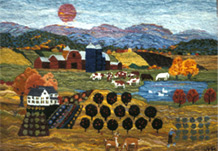
Anne Winterling created this design
based upon her grandfather's farm.
Hooking fabric through a backing is a very ancient technique. Earliest examples of were found in Egyptian tombs. The technique of hooking rugs as we know it today, however, gained popularity in England over 400 years ago. At that time it was called "brodding" or "thrumming."
The tradition of hooking rugs was introduced to America by early colonists. It was a popular home craft for many and provided a use for fabric scraps and usable bits of worn out clothing.
After the Civil War, Edwards Frost from Biddeford, Maine brought rug hooking to a wider audience when he developed techniques for printing affordable rug patterns on burlap. He purchased patterns from women who were known for their creative designs, reproduced them, and sold the patterns throughout the country. During the Depression of the early 1930s, Caroline Saunders of Clinton, Massachusetts encouraged the production of hooked rugs as a creative outlet for women and a way to earn money.
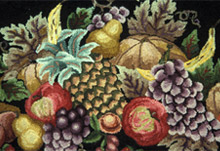
Dot Towle created this welcome mat
featuring an abundance of fruit.
Another important figure in the tradition of rug hooking was Mrs. Pearl K. McGown of West Boylston, Massachusetts. She was a designer, craftsperson, teacher, lecturer, collector, and writer. She published a number of important books on rug hooking and developed a certification standard for teachers of the craft. Each year, one of the largest gatherings of rug making in the United States is held in Worcester, Massachusetts in her name.
For more information on traditional rug hooking, visit these websites
New Hampshire State Council on the Arts
19 Pillsbury Street - 1st Floor, Concord, NH 03301


